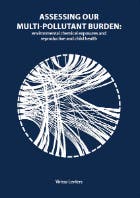Virissa Lenters
Assessing our multi-pollutant burden: environmental chemical exposures and reproductive and child health

- Datum
- (Co) promotoren
- 19-09-2017
- prof.dr.ir. D.J.J. Heederik, prof.dr. A.H. Piersma, dr.ir. R.C.H. Vermeulen, dr. L. Portengen
Samenvatting
Humans are invariably exposed to a myriad of synthetic chemicals on a daily basis through their diet, consumer products, and via the ambient environment. Exposure also occurs in early life as many chemicals transfer from maternal stores into breast milk and across the placenta. However, the health risks of the majority of environmental chemicals are poorly characterized or unknown. In this thesis, we used emerging multi-pollutant statistical methods to evaluate associations between multiple chemical exposures and aspects of reproductive and child health. These methods, namely elastic net penalized regression and sparse partial least squares regression, allow for simultaneous variable selection and effect estimation. In a simulation study of 270 data structures typical of environmental epidemiological analyses, we demonstrated that multi-pollutant approaches, notably penalized regression, yielded fewer false positive discoveries and effect estimates less biased from co-exposure confounding compared to standard assessments of a single exposure. In European and Arctic study populations, we characterized the exposure levels of multiple chemical classes: brominated flame retardants, phthalates, perfluoroalkyl and polyfluoroalkyl substances (PFAS), heavy metals, polychlorinated biphenyls (PCBs), and organochlorine pesticides. In an analysis of chemical exposures in relation to 22 biomarkers of male reproductive function, we detected 10 associations. These included robust associations between a metabolite of diisononyl phthalate (DiNP), which is abundant in polyvinyl chloride materials, and lower testosterone levels; and between PCB-153, a banned yet environmentally persistent chemical, and reduced sperm motility. In another analysis, we found that prenatal exposure to several chemicals was independently associated with birth weight in infants born at term. Low birth weight is a risk factor for chronic disease later in life. The largest effect estimate was observed for perfluorooctanoate (PFOA) and reduced birth weight; the magnitude was nearly half that observed for cotinine, a biomarker of smoking during pregnancy, a well-established risk factor. Lastly, we investigated whether chemical exposures in early life were associated with respiratory health outcomes in childhood, and whether diversity of gut microbiota or levels of short-chain fatty acid (SCFA) metabolites played a role. Perturbations in the composition of commensal microbes in the gut, and of their diversity and metabolic profiles, have been linked to various chronic diseases. Moreover, microbiota can metabolize and modulate the bioavailability and toxicity of chemicals, and chemical exposures can alter microbiota profiles. To our knowledge, this is the first study based on human data to investigate associations between environmental chemicals and markers of gut microbiota, important elements of the external and internal exposome. There were indications, although inconsistent, that some PCBs were prospectively associated with reduced microbial diversity. Several chemicals were associated with an increased risk of asthma, including the organochlorine pesticide β-hexachlorocyclohexane (β-HCH), and some with a decreased risk of asthma, while none were associated with the occurrence of lower respiratory tract infections. We did not find clear evidence that chemical–asthma associations were mediated by SCFAs or microbial diversity. This thesis advances the science of assessing the risks of our chemical burden, and highlights the need for systematic chemical-wide association studies.
